Effects of supplements of water hyacinth and cassava hay on the performance
of local “Yellow” cattle fed a basal diet of rice straw
Cheat Sophal, Khieu Borin* and T R Preston**
Faculty of Animal Science and Veterinary Medicine,
Royal University of Agriculture (RUA), Phnom Penh, Cambodia
sophalcheat@yahoo.com
* Centre for Livestock and Agriculture Development (CelAgrid), Phnom Penh,
Cambodia
** Finca Ecológica, UTA-Colombia, AA#48, Socorro, Santander, Colombia
Abstract
Eighteen male local
“Yellow” cattle with average weight of 101±14.5 kg were allocated in a
randomized complete block design (RCB) to a 3*2 factorial combination of 6
treatments, with three replicates of each treatment. The factors were: 3 sources
of rumen supplement (water hyacinth leaves, water hyacinth leaves + stem and
urea-mineral mixture), and supplementation or not with cassava hay. The basal
diet was untreated rice straw fed ad libitum. The rumen supplements were offered
at levels to provide 100 g crude protein (CP) per 100 kg live weight. The
cassava hay was offered at levels equivalent to 200 g CP per 100 kg live weight.
Live weight gain
was increased dramatically when cassava hay was fed. However, there was a
significant interaction between the effect of the cassava hay and the rumen
supplements. When cassava hay was fed growth rates were higher when the leaves
of water hyacinth were given as the rumen supplement with no difference between
water hyacinth leaves plus stem and the urea-mineral mixture. In the absence of
cassava hay, the cattle fed either leaves or leaves plus stem of water hyacinth
lost body weight while those fed the urea-mineral mixture gained in weight.
It is concluded:
(i) that water hyacinth leaves can be used effectively as a source of rumen
nutrients for growing cattle on a basal diet of rice straw provided a source of
bypass protein (in this case cassava hay) is also fed; and (ii) that the
limiting factors in water hyacinth foliage are the presence of anti-nutritional
factors the negative effects of which are exacerbated at low levels of CP
intake.
Key words: Anti-nutritional factors, bypass
protein, protozoa, rumen ammonia, rumen supplements, urea-minerals
Introduction
Livestock are very important for
the livelihood of the majority of people in developing countries, and also as a
source of renewable energy for draft purposes and as a source of organic
fertilizer for their crops (Steinfeld 2006).
Cambodian
farmers, like those in other developing countries in SE Asia; have various
sources of livelihood, which range from rice farming, vegetable and fruit
cultivation in home gardens, other non-rice crop cultivation in upland areas,
animal husbandry and fishing (Yang Saing Koma 2001). In the farming system,
livestock play a crucial function. Cattle and buffaloes provide most of the
draught power and the manure is used to fertilize crops in the system. Moreover,
they are an important social asset and prestige for the rural farmers.
The total number of cattle and
buffaloes in Cambodia was reported to be around 3 million and 0.7 million,
respectively (MAFF 2004). The number of cattle has fluctuated while buffaloes
have declined slightly during the period 1994-2004. The feeding of cattle and
buffaloes mainly relies on grazing on common areas but at present this has been
significantly declining. Among the constraints for their development appears to
be a lack of fodder supply, particularly in the dry season, which affects the
performance and the production of cattle and buffalo. Due to shortage of
grazing, rice straw plays an important role as a feed source albeit of low
nutritional value. In the rainy season, the feed supply remains poor because the
grazing area used in the dry season is needed for rice production. As a result
of poor management, community land is heavily overgrazed and degraded (Yang
Saing Koma 2001).
Poor-quality feed and fluctuating
feed supplies are the biggest constraints to increasing livestock productivity
in many tropical countries (ILRI 2009). In order to improve this situation,
there is a need to look at ways for extending the availability and quality of
the available feed resources.
Water hyacinth (Eicahronia
crassipes) is a water plant that can be collected locally from rivers, lakes
and ponds in Cambodia, as in other tropical countries. It is one of the fastest
growing plants, which is known to double its biomass in two weeks (Upadhyay et
al 2007). The plant impacts dramatically on water flow, blocks sunlight from
reaching native aquatic plants, starves the water of oxygen, and often kills
fish. Based on these reasons, it has been recommended that water hyacinths
should be removed from water surfaces to limit the disadvantages attributed to
this plant (Skinner 2007). This process would be facilitated if it could be used
as a feed for animals.
Utilization of water hyacinth as
an animal feed has been reported by Hentges (1970), Salveson (1971) and Stephens
(1972). When land forages were limited, cattle have been noticed grazing
floating water hyacinths (Little 1968). Hentges (1970) reported that the amount
of water hyacinth voluntarily consumed by cattle was less than the
requirement for maintenance. In order for water hyacinth to be fed as the basis
of the diet it therefore needs to be complemented with other nutrient-rich
feeds. Water hyacinth foliage is rich in protein and minerals (Abdelhamid
and Gabr 1991), thus the other approach to the use of this plant is
to consider it as a rumen supplement to complement crop residues such as rice
straw which are deficient in such nutrients. For this purpose it needs to supply
readily fermentable nitrogen and minerals as well the “unknown” factors often
associated with green feeds (Preston and Leng 2009). However, even when the
needs of rumen micro-organisms are met, basal diets such as rice straw must also
be supplemented with sources of “bypass” or “escape” protein (Preston and Leng
2009) in order to meet the requirements for production. In this respect cassava
foliage has proved to be a valuable supplement in diets that otherwise supply
only “rumen” nutrients (Ffoulkes and Preston 1978). These authors showed that
fresh cassava foliage supported the same growth rate as soybean meal for
fattening cattle fed a basal diet of molasses-urea. On diets of rice straw fed
to growing cattle, rates of live weight gain were increased by supplements of
fresh cassava foliage (Seng Mom et al 2001), cassava leaf meal (Ho Thanh Tham
2008) and sun-dried cassava hay (Keo Sath et al 2007).
For the above reasons it was
decided to evaluate the potential advantages of combining fresh water hyacinth
and sun-dried cassava foliage (hay) as respective sources of rumen nutrients and
bypass protein in a basal diet of rice straw fed to growing cattle of the
local “Yellow” breed.
Hypotheses
The hypotheses to be tested were:
·
Giving water hyacinth foliage as a supplement to rice straw fed to
local “Yellow” cattle will have a similar effect as a “rumen” supplement
containing urea, and minerals
·
Water hyacinth leaves will have a better feeding value than the
whole aerial part containing stems as well as leaves
·
Cassava hay will supply bypass protein and therefore, because all
diets are devoid of bypass protein, will enhance performance on all the diets
Materials and methods
Location
The experiment was carried out at
the Animal Research Station of the Faculty of Animal Science and Veterinary
Medicine, Royal University of Agriculture (RUA), Phnom Penh capital city,
Kingdom of Cambodia, for 72days from November 08, 2009 to January 17, 2010.
Experimental design
The experiment was designed as a
randomized complete block (RCB) with 3 replicates per treatment. The treatments
were arranged as a 3*2 factorial, in which the factors were:
Rumen supplement:
·
Water hyacinth leaf (WHL)
·
Water hyacinth leaf and stem (WHLS) and
·
Urea-mineral mixture (UM)
Bypass protein supplement
·
With cassava hay (CH)
·
Without cassava hay
|
Table 1
The 3*2 factorial arrangement of 3 supplements, with or without
cassava hay |
|
|
WH leaf |
WH leaf + stem |
Urea-mineral mixture |
|
With
cassava hay |
WHL-CH |
WHLS-CH |
UM-CH |
|
Without
cassava hay |
WHL |
WHLS |
UM |
Experimental feeds
All animals received a basal diet
of untreated rice straw
ad libitum and either supplements of WHL, WHLS or UM (Table 2) each of
which was provided at a level to supply 100g of crude protein (N*6 25) per 100kg
LW.
|
Table 2.
Composition of the urea-mineral mixture for cattle |
|
Ingredient |
%, fresh basis |
|
Sugar palm
syrup |
27 |
|
Water |
13 |
|
Rice bran |
33.5 |
|
Urea |
13 |
|
Diammonium
phosphate (DAP) |
3 |
|
Salt |
5 |
|
Lime |
5 |
|
Sulfur |
0.5 |
|
Adapted from Seng Mom et al (2001) |
Animals on three of the six
treatments (WHL-CH, WHLS-CH and UM-CH) received an additional supplement of
cassava hay at 1% of live weight (DM basis). This was planned to provide
approximately 200g/day of additional crude protein to a 100 kg live weight
animal.
Ingredients for making
urea-minerals mixture
were bought from a local market near the experimental site while fresh
cassava foliage was obtained from plants that were three months old from farm
households in Kampong Cham province. Cassava leaves and petioles were separated
from the hard stem and sun dried for about 5 to 7 days on a plastic sheet placed
on the ground until the leaves became crisp (>85% DM) (Photo 1). Rice straw of
the same variety was bought from farmers at the harvest time. Water hyacinth
(Photo 2) was collected daily from the lagoon located close to RUA.
Animals and management
Local male “Yellow” cattle (Photo 3) with
mean live weight of 101±14.5 kg were housed in individual pens (photo 4) where
they could have free access to the rice straw and water. Before starting the
experiment, the cattle were drenched with Ivermectin (1% of Ivermectin
concentration) and vaccinated against foot and mouth disease (FMD) and
Pasteurellosis (Heamorraghic Septicaemia). The water hyacinth and urea-minerals
mixture were given as the first feed in the morning at 07:00h. At 09:00h and
16:00h the cattle were offered the cassava hay and rice straw.
 |
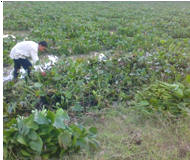 |
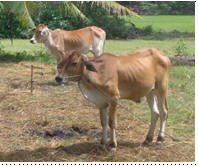 |
|
Photo 1.
Sun-dried cassava (hay) |
Photo 2.
Water hyacinth
collecting from lagoon |
Photo 3.
The experimental
local “Yellow” cattle |
|
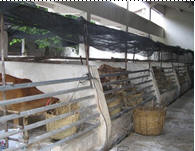 |
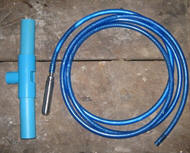 |
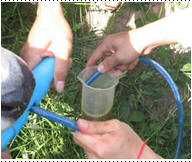 |
|
Photo 4.
Experimental cattle
kept in individual pens |
Photo 5.
The stomach tube and gag |
Photo 6.
The way of taking rumen fluid |
Data collection
Feeds
offered were weighed before giving them to the cattle. Feed refusals were
collected each morning prior to offering fresh feed and weighed to measure the
feed intake. Representative samples of feeds offered and refusals were collected
for chemical analysis. The live weights of the cattle were taken at the
beginning, every 2 weeks and at the end of the experiment. Samples of rumen
fluid were taken by a stomach tube (Photos 5 and 6) two hours post feeding in
the morning at 4, 8 and 10 weeks for counting of protozoa and determining rumen
ammonia and pH. The samples for counting of
protozoa were stabilized by adding formaldehyde saline solution
(10% formaldehyde and 0.9% NaCl) at the rate of 1ml
per 10 ml of rumen fluid and kept in the refrigerator at -20oC for
later counting. For rumen ammonia analysis, 0.3 ml of 50% H2SO4
was added to 15.0 ml of rumen fluid (Korhonen et al 2002).
Chemical analyses
Water hyacinth leaves plus stems,
water hyacinth leaves, cassava hay and rice straw and the urea-mineral mixture
and feed refusals were analyzed for dry matter (DM), nitrogen (N) and ash
following the methods of AOAC (1990). Acid detergent fiber (ADF), and neutral
detergent fiber (NDF) were determined by the methods of Van Soest et al (1991).
The numbers of rumen protozoa were counted using a Whitlock universal (worm egg
counting) chamber under a microscope at 10x magnification. Rumen pH was measured
immediately after taking rumen fluid from the animal with a digital pH meter.
Data analyses
Data for feed intake, growth and
feed conversion were analyzed with the Generalized Linear Model option of the
ANOVA program in the MINITAB software (Version 13.31) (Minitab 2000). Sources of
variation were rumen supplements, with or without cassava hay (bypass protein
supplement), interaction between rumen supplement and with or without cassava
hay and error. When there was a significant difference at P<0 05, the means were
compared using Tukey’s procedure in the same MINITAB software. When there were
trends in animal responses, linear regressions were calculated using the MINITAB
software.
Results and discussion
Chemical composition of feeds
The DM and crude protein (CP = N*6
25) contents of water hyacinth leaves+stems (whole aerial part) were higher than
was reported by Aboud et al (2005) but values for ADF, NDF and ash were lower
(Table 3). Leaves of water hyacinth had higher DM, CP and lower ADF and NDF than
the combined leaves+stems. On an “as fed” basis the water hyacinth aerial part
was only 35% leaf (Table 4). In the cassava hay the proportion of leaf was 71%.
|
Table 3 Chemical
composition of feeds |
|
|
DM |
CP |
Ash |
OM |
ADF |
NDF |
|
% |
% of DM |
|
Water hyacinth leaves+stems |
14.5 |
16.2 |
15.7 |
84.3 |
30.0 |
54.2 |
|
Water hyacinth leaves |
18.3 |
19.5 |
12.2 |
87.8 |
28.2 |
49.9 |
|
Cassava hay |
86.1 |
25.9 |
10.9 |
89.1 |
35.8 |
57.7 |
|
Urea-mineral mixture |
64.7 |
64.1 |
20.5 |
79.5 |
- |
- |
|
Rice straw |
89.3 |
3.9 |
13.7 |
86.3 |
51.9 |
69.7 |
|
DM = dry matter, CP = crude protein, N = nitrogen, OM = organic
matter, ADF = acid detergent fiber, NDF = neutral detergent fiber |
|
Table 4 Proportion of
leaf and stem of water hyacinth and leaf and stem +
petiole of cassava hay (as fed basis) |
|
|
Leaf |
Stem/petiole |
|
Water hyacinth |
35.3 |
64.7 |
|
Cassava hay, |
70.6 |
29.4 |
The chemical composition of water
hyacinth varies considerably, according to where it grows and when it is
harvested. The comparisons made here are with water hyacinth growing in Tanzania
and in Thailand. The high CP content of the leaves can be considered as
favorable for feeding to ruminants thus the leaves may be regarded as a valuable
fermentable N supplement for animals fed on low protein crop residues. For
cassava hay, the ash, ADF and NDF contents were higher, but CP was comparable to
that reported by Wanapat et al (1997).
Feed intake
Total DM intakes were increased by
feeding cassava hay and by feeding water hyacinth leaves compared with
leaves+stems (Tables 5 and 6; Figures 2 and 3). DM intake on the UM rumen
supplement treatment was lower than when water hyacinth was fed – in the
presence of cassava hay. The opposite was observed in the absence of cassava
hay, when rice straw intake and total DM intakes were higher for the UM
treatment than for treatments with water hyacinth. The CP levels of the diets
were lower in the absence of cassava hay and were only marginally above the
minimum level needed for efficient rumen function (Perdok and Leng 1989). In
this situation the water hyacinth treatments were inferior to the urea-mineral
treatment, because of the lower total DM intake of the former compared with
that of the UM treatment group.
|
Table 5
Mean values (main
effects) for daily feed and crude protein intake for “Yellow” cattle
fed rice straw supplemented with water hyacinth leaves, water
hyacinth leaves+stems or urea-mineral mixture, in each case with or
without cassava hay |
|
|
Cassava hay |
SEM |
Prob |
Rumen supplement |
SEM |
Prob |
|
With |
Without |
WHL |
WHLS |
UM |
|
DM intake, g/day |
|
|
|
|
|
|
|
|
|
WHLS |
205b |
235a |
4.24 |
0.001 |
|
661 |
|
|
|
|
WHL |
201 |
205 |
2.78 |
0.321 |
610 |
|
|
|
|
|
CH |
689 |
|
|
|
404a |
362b |
268c |
9.29 |
0.001 |
|
UM |
23b |
48a |
1.09 |
0.001 |
|
|
107 |
|
|
|
Rice straw |
1497b |
1735a |
19.8 |
0.001 |
1552b |
1383c |
1913a |
24.2 |
0.001 |
|
Total |
2616a |
2223b |
23.3 |
0.001 |
2566a |
2405b |
2287c |
28.5 |
0.001 |
|
DM intake, % of LW |
2.41a |
2.15b |
0.052 |
0.005 |
2.37 |
2.3 |
2.17 |
0.063 |
0.111 |
|
CP intake, g/day |
|
|
|
|
|
|
|
|
|
WHLS |
33b |
38a |
0.69 |
0.001 |
|
107 |
|
|
|
|
WHL |
39 |
40 |
0.54 |
0.321 |
119 |
|
|
|
|
|
CH |
178 |
|
|
|
105a |
94b |
69c |
2.41 |
0.001 |
|
UM |
15b |
31a |
0.70 |
0.001 |
|
|
69 |
|
|
|
Rice straw |
58b |
68a |
0.77 |
0.001 |
60.5b |
54c |
75a |
0.94 |
0.001 |
|
Total |
324a |
176b |
2.64 |
0.001 |
284a |
255b |
213c |
3.23 |
0.001 |
|
CP in DM |
0.13a |
0.09b |
0.005 |
0.001 |
0.11 |
0.1 |
0.11 |
0.006 |
0.53 |
|
DM = dry matter, CP = crude protein, WHLS = water hyacinth
leaves+stems, WHL = water hyacinth leaves,
UM = urea minerals paste, CH = cassava hay, SEM = standard error of
the mean
-a
,b, c mean values with different superscripts within the same
row and main effect are different at P<0 05 |
|
Table 6
Mean values for daily
feed and crude protein intake for “Yellow” cattle fed rice straw
supplemented with water hyacinth leaves, water hyacinth leaves+stems
or urea-mineral mixture, in each case with or without cassava hay |
|
Item |
Cassava hay |
No cassava hay |
SE |
Prob |
|
WHL |
WHLS |
UM |
WHL |
WHLS |
UM |
|
DM intake,
g/day |
|
|
|
|
|
|
|
|
|
WHLS |
|
616 |
|
|
705 |
|
|
|
|
WHL |
604 |
|
|
616 |
|
|
|
|
|
CH |
809 |
723 |
535 |
|
|
|
|
|
|
UM |
|
|
70 |
|
|
144 |
|
|
|
Rice straw |
1582b |
1343b |
1565b |
1522b |
1422b |
2260a |
34.2 |
0.001 |
|
Total |
2994a |
2682b |
2171de |
2137de |
2127e |
2403c |
40.3 |
0.001 |
|
DM intake, %LW |
2.64ab |
2.5ac |
2.08c |
2.11ac |
2.09c |
2.26abc |
0.089 |
0.004 |
|
CP intake,
g/day |
|
|
|
|
|
|
|
|
|
WHLS |
|
100 |
|
|
114 |
|
|
|
|
WHL |
118 |
|
|
120 |
|
|
|
|
|
CH |
209 |
187 |
139 |
|
|
|
|
|
|
UM |
|
|
45 |
|
|
92 |
|
|
|
Rice straw |
62b |
52b |
61b |
59b |
56b |
88a |
1.34 |
0.001 |
|
Total |
389a |
340ab |
245b |
179b |
170b |
180b |
4.57 |
0.001 |
|
CP in DM |
0.13 |
0.13 |
0.11 |
0.09 |
0.08 |
0.10 |
0.008 |
0.738 |
|
a-e
mean values with different superscripts within the same row are
different at P<0.05 |
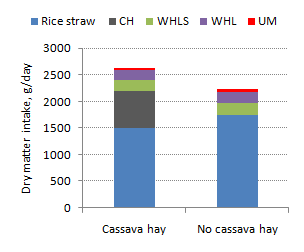 |
Figure 1. Dry matter intake
of dietary ingredients for “Yellow” cattle fed rice straw
supplemented with water hyacinth leaves, water hyacinth leaves+stems
or
urea-mineral mixture, in each case with or without cassava hay |
 |
 |
Figure 2. Total DM intake for
“Yellow” cattle fed rice straw
supplemented with water hyacinth
leaves, water hyacinth
leaves+stems or urea-minerals mixture, in
each case
with or without cassava hay |
Figure 3. CP intake for
“Yellow” cattle fed rice straw supplemented
with water hyacinth
leaves, water hyacinth leaves+stems or
urea-minerals mixture, in
each case
with or without cassava hay |
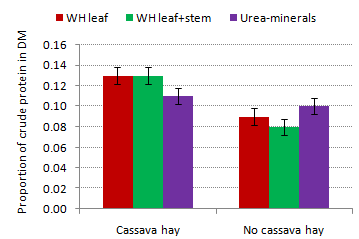 |
Figure 4. Proportion of CP
in DM for “Yellow” cattle fed rice straw supplemented
with water
hyacinth leaves, water hyacinth leaves+stems or urea-minerals
mixture, in each case with or without cassava hay |
Rumen parameters
The concentration of rumen
ammonia was increased by feeding cassava hay and was higher when urea-minerals
was the rumen supplement rather than water hyacinth (Tables 7 and 8; Figure 4).
The pH values varied only slightly among treatments and all were within the
normal range for adequate rumen function (Preston and Leng 2009). Protozoal
populations were not affected by dietary treatments but were lower by a factor
of 10 compared to data reported by Seng Mom et al (2001) (populations of
protozoa (3-4*104/ml) for similar animals fed similar diets.
|
Table 7
Mean values (main
effects) for rumen pH, ammonia and protozoal population in “Yellow”
cattle fed rice straw supplemented with water hyacinth leaves, water
hyacinth leaves+stems or urea-minerals mixture, in each case with or
without cassava hay |
|
Item |
Cassava hay |
SEM |
Prob |
Rumen supplement |
SEM |
Prob |
|
With |
Without |
WHL |
WHLS |
UM |
|
pH |
6.92 |
6.98 |
0.023 |
0.061 |
6.98a |
6.98a |
6.88b |
0.028 |
0.018 |
|
NH3, mg/litre |
190a |
144b |
10.2 |
0.003 |
150b |
141b |
210a |
12.7 |
0.001 |
|
Protozoa, *10-4/ml |
0.194 |
0.277 |
0.044 |
0.19 |
0.209 |
0.274 |
0.223 |
0.054 |
0.67 |
|
a,b
mean values with different superscripts within the same row and main
effect are different at P<0 05 |
|
Table 8
Mean values for rumen
pH, ammonia and protozoal population in “Yellow” cattle fed rice
straw supplemented with water hyacinth leaves, water hyacinth
leaves+stems or urea-minerals mixture, in each case with or without
cassava hay |
|
Item |
Cassava hay |
No cassava hay |
SEM |
Prob |
|
WHL |
WHLS |
UM |
WHL |
WHLS |
UM |
|
pH |
6.96a |
7.03a |
6.78b |
7.01a |
6.94a |
6.99a |
0.04 |
0.003 |
|
NH3, mg/litre |
186a |
176ab |
208a |
113b |
106b |
212a |
17.7 |
0.057 |
|
Protozoa, *10-4/ml |
0.095 |
0.268 |
0.219 |
0.324 |
0.280 |
0.226 |
0.076 |
0.25 |
|
a ,b
mean values with different superscripts within the same row are
statically significant different at P<0 05 (a>b) |
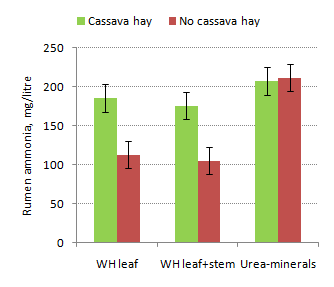 |
Figure 5. Mean values of
rumen ammonia for “Yellow” cattle fed rice straw
supplemented
with water hyacinth leaves, water hyacinth leaves+stems or
urea-minerals mixture, in each case with or without cassava hay |
Growth rate
Live weight gain was higher when
cassava hay was fed (Table 9). However, there was a significant interaction
between the main treatments (Figures 6 and 7). When cassava hay was fed growth
rates were higher when the leaves of water hyacinth were given as the rumen
supplement with no difference between water hyacinth leaves plus stems and the
urea-mineral mixture (Table 10). In the absence of cassava hay, the cattle fed
either leaves or leaves plus stems of water hyacinth lost body weight while
those fed the urea-mineral mixture gained in weight (Table 10; Figures 6 and 7).
The growth rate on the best treatment of cassava hay and water hyacinth leaves
(243 g/day) was similar to that (250 g/day) reported by Seng Mom et al (2001)
for “Yellow” cattle fed rice straw supplemented with urea minerals and cassava
foliage, and is probably close to the genetic potential of this “small” breed.
The differences in rate of live
weight gain (or loss) reflected the differences in DM intake (Figures 8) and the
crude protein intake (Figure 9).
|
Table 9
Mean values (main
effects) for total DM intake and live weight in “Yellow” cattle fed
rice straw supplemented with water hyacinth leaves, water hyacinth
leaves+stems or urea-mineral mixture, in each case with or without
cassava hay |
|
Item |
Cassava hay |
SE |
Prob |
Rumen supplement |
SE |
Prob |
|
With |
Without |
WHL |
WHLS |
UM |
|
DM intake,
g/day |
2616a |
2223b |
23.3 |
0.001 |
2566a |
2405b |
2287c |
28.5 |
0.001 |
|
Live weight, kg |
|
|
|
|
|
|
|
|
|
|
Initial |
102 |
102 |
6.2 |
0.98 |
103 |
101 |
102 |
7.6 |
0.98 |
|
Final |
115 |
104 |
6.5 |
0.25 |
111 |
107 |
111 |
7.9 |
0.90 |
|
Daily gain,
g/day |
177a |
18b |
15 |
0.001 |
113 |
67 |
114 |
18 |
0.16 |
|
a,b,c
mean values with
different superscripts within the same row and main effect are
different at P<0.05 |
|
Table 10
Mean values for total
DM intake, live weight and feed conversion for “Yellow” cattle
fed rice straw supplemented with water hyacinth leaves, water
hyacinth leaves+stems or urea-mineral mixture, in each case with
or without cassava hay |
|
Item |
Cassava hay |
No cassava hay |
SE |
Prob |
|
WHL |
WHLS |
UM |
WHL |
WHLS |
UM |
|
Total DM
intake, g/day |
2994a |
2682b |
2171de |
2137de |
2127e |
2403c |
40.3 |
0.001 |
|
Live
weight, kg |
|
|
|
|
|
|
|
|
|
Initial |
103 |
101 |
101 |
102 |
100 |
103 |
10.7 |
0.99 |
|
Final |
121 |
113 |
113 |
102 |
101 |
109 |
11.2 |
0.81 |
|
Weight
change, g/day |
243a |
147a |
141ac |
-17b |
-13b |
86bc |
25 |
0.009 |
|
FCR |
12.3±6.6 |
20.8±6.6 |
16.8±8.0 |
# |
# |
34.5±6.6 |
|
|
|
a
,b mean values with
different superscripts within the same row are different at
P<0.05)
# FCR cannot be calculated as the animals lost live weight
during the experiment |
 |
Figure 6.
Growth curves for “Yellow” cattle fed rice straw supplemented with
water hyacinth leaves, water hyacinth leaves+stems or urea-minerals
mixture, in each case with or without cassava hay |
The positive growth response to
the cassava hay supplement is in agreement with a wide body of recent reports in
which cassava foliage was supplemented to rice straw as the basal diet (Seng Mom
et al 2001, Ho Thanh Tham 2008; Keo Sath et al 2007). The better growth on water
hyacinth leaves compared with leaves+stems may in part be due to the greater
concentration of cell wall compounds in the stems, resulting in a lower
digestibility, The interesting result, however, is in the interaction between
cassava hay and the rumen supplements (Figure 7).
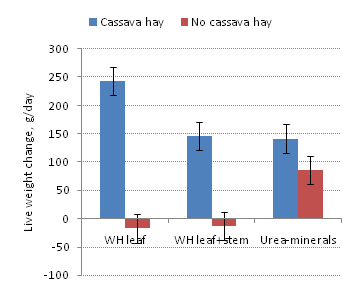 |
Figure 7.
Mean values for live weight change for “Yellow” cattle fed rice
straw
supplemented with water hyacinth leaves, water hyacinth
leaves+stems
or urea-mineral mixture, in each case with or
without cassava hay |
When cassava hay was fed, there
were no differences between the rumen supplements of water hyacinth leaves+stems
and urea-. However, in the absence of cassava hay, growth was positive with the
urea-mineral supplement and negative with water hyacinth leaves and
leaves+stems. The implication for these findings is there may be
anti-nutritional compounds in the water hyacinth which exerted negative effects
on animal metabolism when the protein status of the animal was low (ie: in the
absence of cassava hay supplementation). That these negative effects were not
evident when cassava hay was fed can be explained by the known positive effects
of higher dietary protein levels in animals subjected to disease stress,
including that induced by intake of toxic compounds (Leng 2005).
The critical role of the protein
supply is evident from the positive relationships between the crude protein
consumed and the DM intake and the live weight gain (Figures 8, 9 and 10). The
positive relationship between rumen ammonia concentration and live weight gain
(Figure 11), supports the idea that the N supply to rumen micro-organisms, as
well as the protein supply to the animal, were important factors determining
animal growth responses.
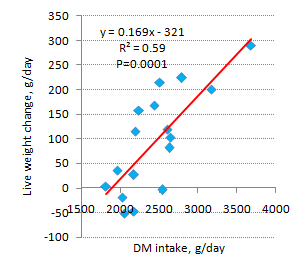 |
 |
Figure 8. Relationship
between dry matter intake and live weight change
for “Yellow”
cattle fed rice straw supplemented with water hyacinth
leaves,
water hyacinth leaves+stems or urea-mineral mixture,
in each
case with or without cassava hay |
Figure 9. Relationship
between crude protein intake and live weight change
for “Yellow”
cattle fed rice straw supplemented with water hyacinth
leaves,
water hyacinth leaves+stems or urea-mineral mixture,
in each
case with or without cassava hay |
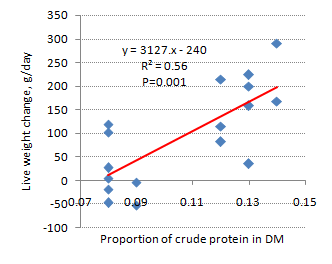 |
Figure 10.
Relationship between proportion of crude protein in dray matter and
live weight change for “Yellow” cattle fed rice straw supplemented
with
water hyacinth leaves, water hyacinth leaves+stems or
urea-mineral
mixture, in each case with or without cassava hay |
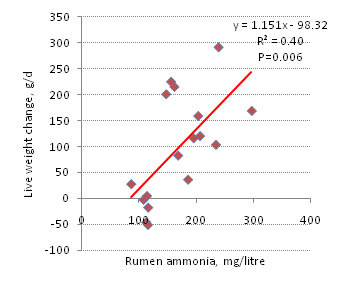 |
Figure 11. Relationship
between rumen ammonia and live weight change for
“Yellow” cattle
fed rice straw supplemented with water hyacinth leaves,
water
hyacinth leaves+stems or urea-mineral mixture, in each case
with
or without cassava hay |
Support for the concept of the
presence of anti-nutritional compounds in water hyacinth can be found in the
report of Hentges (1970) that cattle could not eat enough fresh water hyacinth
to cover their maintenance requirement. Kahn (1977) also found that green water
hyacinth alone was insufficient for the maintenance of bullocks as the animals
lost 23 g/day of live weight during a period of 60 days. However, when rice
straw was given together with the water hyacinth (1:1 ratio) the bullocks
increased their DM intake by 67% and gained 68g/day of live weight. On the basis
of proximal analysis, rice straw has a much lower nutritive value (less crude
protein and more cell wall compounds) than water hyacinth. In this case, the
positive effects from adding a feed of lower nutritional value could be due to
the diluting effect of the rice straw on the anti-nutritional compounds in water
hyacinth.
There is
confusing evidence on the presence of anti-nutritional compounds in water
hyacinth. Lareo and Bressani (1982) stated: “that the levels of
anti-physiological factors present in the plant are either very low or
non-existent. We found tannins in amounts of only about 1 per cent of the dry
matter from the whole plant and 2 per cent in the leaves. The plant as a whole
does not have trypsin inhibitors. The tests for saponins and alkaloids were
negative, and the level of oxalates was only 0.8 per cent”. Abdelhamid and Gabr
(1991) also reported low levels of total tannins of only 0.13% in the DM of
water hyacinth leaves. In marked contrast, Dutta et al (1984) reported total
tannins of 2% in DM in the leaves of water hyacinth. No information was given on
the condensed tannin fraction, which can combine with protein to make it
insoluble. In any event, even 2% of tannins are not likely to be a problem as
the safe upper level of condensed tannins was indicated to be of the order 5 to
6% in DM by Reed (1995), while levels of 4% were considered by Barry (1987) to
be advantageous in enhancing the “bypass” characteristics of the protein.
The presence
of toxic heavy metals – lead and mercury – in water hyacinth was reported to be
a risk factor by Skinner (2007). However, there seems to be no evidence linking
these elements with ruminant animal responses to feeding water hyacinth. What
appears to be consistent is the depression in animal growth responses when water
hyacinth leaves are fed in increasing amounts up to the point of being the sole
diet. Thus Abdelhamid and Gabr (1991) fed sheep on diets of rice
straw and concentrates, with increasing proportions of fresh water hyacinth
leaves until the sole diet was water hyacinth. DM intake decreased linearly with
increasing proportions of water hyacinth in the diet being only 420 g DM/day
with 100% water hyacinth compared with 1290 g/day on the control diet of 30%
concentrates and 70% rice straw. They showed that these responses were not
related to the apparent nutritive value of the diets as apparent DM
digestibility (56-58%) was similar on the control and 100% water hyacinth diets,
while the DCP was 13% for water hyacinth compared with 5% for the control diet.
These same authors also quoted reports from farmers who used water hyacinth as a
green fodder that all rabbits and geese died, soon after eating water hyacinth.
The toxicity for rabbits of water hyacinth as the sole diet was recently
reported in Vietnam (Bui Phan Thu Hang 2010, personal communication). There were
no problems when the water hyacinth was diluted with 50% of its weight as water
spinach. Osman et al (1975) came to the same conclusion that feeding with the
fresh plant alone is not possible. The physiological problems caused by the
biochemical components of the water hyacinth remained the same after drying the
plants according to Becker et al (1987). This would seem to rule out calcium
oxalate as a factor limiting intake since drying Taro (Colocacia esculenta)
leaves eliminates the limitations to intake caused by the high levels of calcium
oxalate in the leaves of this plant (Pheng Buntha et al 2008). At the same
time many authors did not find health problems from feeding water hyacinth
(Moursi 1976 and El-Serafy et al 1980) but they, along with other authors
(Hathout et al 1980; Tagel-Din et al 1989; Zahran et al 1989) recommended its
use with appreciable amounts of concentrates.
Conclusions
-
Supplementation of a rice straw diet with water hyacinth leaves and cassava
hay supported normal growth in local “Yellow” cattle
-
In the absence of cassava hay, the cattle lost weight when the rumen
supplement was water hyacinth leaves or leaves+stems, while those given a
urea-mineral supplement gained weight
-
It is postulated that there are anti-nutritional compounds present in water
hyacinth leaves which at low overall protein intakes lead to reduced feed
intake and loss of body weight
-
Water hyacinth foliage should never be fed as the sole diet of ruminants but
may be fed at up to 25% of the diet DM along with protein-rich supplements
Acknowledgements
The authors are grateful to the MEKARN project, financed by Sida, Sweden for the
support for this research. The Royal University of Agriculture, Phnom Penh,
Kingdom of Cambodia is acknowledged for provision of research facilities.
References
Abdelhamid A M and Gabr A 1991
Evaluation of water hyacinth as a feed for
ruminants Archives Animal Nutrition • Berlin 41 (1991) 7/8
745-756
Aboud A A O, Kidunda R S and Osarya J 2005:
Potential of water hyacinth (Eicchornia
crassipes) in ruminant nutrition in Tanzania Livestock Research
for Rural Development Vol 17, Art #96 Retrieved
April 30, 2010, from
http://www lrrd
org/lrrd17/8/abou17096 htm
AOAC 1990
Official Method of Analysis
Association of Official Analytical Chemists 15th edition (K
Helrick editor) Arlington pp 1230
Barry T N 1987 Secondary Compounds of
forages in Nutrition of herbivores. Hacken J B and Termouth J H (editors). AP
Sydney. Pp. 91-120.
Becker K, Mahler F and Gall C 1987
Animal Research Development 25, 45
Dutra R K, Sahu B K, Panda N C and Nayak B C
1984 Indian Journal of Animal Science
54, 594 Egypt.-British Conf. on Anim., Fish and Poultry Prod., Alexandria, Egypt
El-Serafy A M, Allam S M, El-Ashry M
A, Kilaltab H M, SowIan H S and Swidan F
Z 1980
Dry matter intake and nutrients
digestibility of water hyacinth hay, haylage and silage by buffalo steers.
Indian Journal of Animal Science. 57: 698-701.
Ffoulkes D and Preston T R 1978
Cassava or sweet potato forage as combined
sources of protein and roughage in minerals based diets: effect of
supplementation with soybean meal Tropical Animal Production (3): 186-192
http://www.utafoundation.org/TAP/TAP33/3_3_1.pdf
Hentges J F Jr 1970
Processed aquatic weeds for cattle nutrition Proceedings Aquatic Plant
Research Conference, University of Florida, Gainesville
ILRI 2009 Forage diversity http://www.ilri.org/ForageDiversity
Kahn M J 1977
Studies on the composition, voluntary intake and digestibility of water hyacinth
(Eichhornia crassipes) and its effect on the growth of cattle MSc Thesis
submitted to Bangladesh Agricultural University
Keo Sath, Khieu Borin and Preston T R 2008
Effect of levels of sun-dried cassava foliage on growth
performance of cattle fed rice straw. Livestock
Research for Rural Development. Volume 20, supplement.
http://www.cipav.org.co/lrrd/lrrd20/supplement/sath2.htm
Lareo L and Bressani R 1982
Possible utilization of the water hyacinth in nutrition and industry.
Food and Nutrition Bulletin.
Volume 4,
Number 4,
United Nations
University,
Tokyo,
Japan.
http://www.unu.edu/unupress/food/8f044e/8F044E00.htm#Contents
Leng R A 2005 Metabolisable
protein requirements of ruminants fed roughage based diets.
In Proceedings of AHAT/BSAT International Conference
Integrating
Livestock-Crop systems to meet the challenges of globalisation (Editors: P
Rowlinson, C Wachirapakorn, P Pakdee and M Wanapat), November 14-18, 2005, Khon
Kaen, Thailand.
Little E C S (Editor) 1968
Handbook of Utilization of Aquatic Plants F A O of the U N
Rome, Italy
MAFF 2004 Ministry of
Agriculture, Forestry and Fisheries
http://www maff gov
kh/eng/statistics/livestock html#a1
Moursi H A 1976
Symposium on Nile water and Lake Dam Projects, Cairo, P: I
Osman H E, El-Hag G A
and Osman M K 1975
Aquatic weeds in the Sudan with
special reference to water hyacinth. National Council for Research In: Obeid M
(Ed ) Aquatic weeds in the Sudan
Perdok H B and
Leng R A 1989 Rumen ammonia requirements for
efficient digestion and intake of straw by cattle. In: Protozoa and Fungi in
Ruminant Digestion: Proceedings of an OECD/UNE International Seminar, 26- 29
September 1988. pp. 291-293 (J V Nolan, R A Leng and D I Demeyer. editors].
Armidale, NSW: Penambul Books.
Pheng Buntha, Khieu Borin, Preston T R and Ogle B 2008
Survey
of taro varieties and their use in selected areas of Cambodia
Livestock
Research for Rural Development Volume 20, supplement
Retrieved May
25, 2010, from
http://www.lrrd.org/lrrd20/supplement/bunt1 htm
Preston T R and Leng R A 2009
Matching ruminant production systems with available resources in the tropics
and subtropics
http://www utafoundation org/P&L/preston&leng htm
Reed J D 1995
Nutritional toxicology of tannins and related polyphenols in forage legumes.
Journal of Animal Science 73:1516
http://jas.fass.org/cgi/reprint/73/5/1516.pdf
Salveson, R E 1971
Utilization of aquatic plants in steer diets: Voluntary intake and digestibility
MSA Thesis University of Florida, Gainesville
Seng Mom, Preston T R, Leng R A and Meulen U ter 2001
Response of young cattle fed rice straw to supplementation with cassava foliage
and a single drench of cooking oil Livestock Research for Rural
Development (13) 4:
http://www lrrd org/lrrd13/4/seng134 htm
Skinner Kathleen 2007
"Mercury uptake and accumulation by four species of aquatic plants"
Environmental Pollution (Elsevier)
145 (1): 234–237
doi:10
1016/j envpol 2006 03 017
http://en wikipedia
org/wiki/Water_hyacinth
Steinfeld Henning 2006 Rearing
cattle produces more greenhouse gases than driving cars, UN report
http://www un org/apps/news/story asp?NewsID=20772&Cr=global&Cr1=environment
Stephens E L 1972
Digestibility trials on ten elements and three toxicants in aquatic plant diets
fed steers M S A Thesis University of Florida,
Tagel-Din A E, Nour A M , Nour
A A and Ahmed A H 1989
Proc 3rd Egypt -British Conf on Anim., Fish and Poultry Prod.,
Alexandria, Egypt.
Tham H T, Man N V and Preston T R 2008
Performance
of young cattle fed rice straw sprayed with mixture of urea and minerals
supplemented with different levels of cassava leaf meal
Livestock
Research for Rural Development Volume 20, supplement
Retrieved May
25, 2010, from
http://www cipav org
co/lrrd/lrrd20/supplement/tham1 htm
Upadhyay, Alka R and
Tripathi B D 2007
"Principle
and Process of Biofiltration of Cd, Cr, Co, Ni & Pb from Tropical Opencast
Coalmine Effluent"
Water, Air, & Soil Pollution
(Springer) 180 (1 - 4): 213–223
http://en wikipedia
org/wiki/Water_hyacinth
Van Soest P J, Robertson J B and Lewis B A 1991
Methods for dietary fiber, neutral detergent fiber, and non-starch
polysaccharides in relation to animal nutrition Journal of Dairy Science
74:3583-3597
http://download.journals.elsevierhealth.com/pdfs/journals/0022-0302/PIIS0022030291785512.pdf
Wanapat M, Pimpa O, Petlum A and Boontao U 1997
Cassava hay: A new strategic feed for ruminants during the dry season
Livestock Research for Rural Development (13) 4:
http://www lrrd org/lrrd9/2/metha92
htm
Yang Saing Koma 2001
Assessment of the current state of agriculture, forestry and marine resources:
Sustainable Agriculture, Japan International Volunteer Centre,
Zahran S M, Ahmed M H , Tagel-Din A
E , Nour A M and Abou-Akkada A R 1989
Proceedings 3rd Egypt -British Conference on Animal, Fish and Poultry
Production, Alexandria, Egypt.
Go to top
















